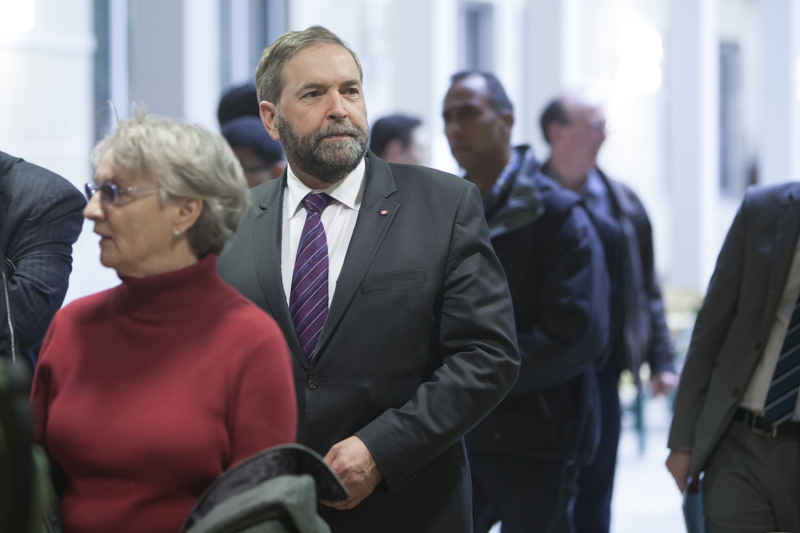Back in 2014, 34 ONDP supporters signed a letter criticizing the right-wing strategy that the party had taken during the Ontario election. When the letter dropped, signatory Judy Rebick told the CBC that the ONDP, “seem[s] to be running on a kind of right-wing populism, not at all on party policy, or in any way talking about social justice or democracy.”
Party loyalists were swift to condemn the letter for a variety of reasons, but the most consistent criticism was that the timing was bad. Demanding that a party change course mid-election is unfeasible and worse, irresponsible, many said.
And in some ways, fair enough. It is difficult to change direction mid-election. Perhaps the “Gang of 34” should have lodged their criticisms outside of an election period. Would that have made the party take their concerns more seriously?
Probably not.
That moment, now nearly two-and-a-half years ago, demonstrated one of the key problems that exists within the NDP and many of its provincial counterparts: there is a vast gulf between the democratic decisions of its members and the party’s election strategy.
Many argue that the NDP has to play the political game of the Liberals and Conservatives if it’s going to get elected. This means that during election periods, campaign strategy is intimately tied to political demands.
Demands are dangled at certain times in the campaign for maximum impact. They may or may not reflect party policy. They may or may not reflect progressive politics. Some demands should react or respond to other parties’ demands. Polls become king and party policies as voted on by members are relegated to policy conventions.
During the 2014 campaign, the ONDP’s campaign team apparently thought that tapping into right-wing populism with promises like HST off hydro bills would win. The 2015 NDP campaign had a much bolder vision of a progressive Canada but was still elbowing the Liberals out of way for centrist supremacy.
Despite the differences in campaigns, both were rooted in playing another party’s game. A progressive party needs to build from the momentum that exists among its members, and then put forward their vision for a better province or country. To do this, they must break with conventional wisdom as it has been defined by the other parties.
A campaign built on members’ aspirations forces accountability and allows for people who join the party to get involved and see themselves reflected in the movement, from developing policies right through to an election. There is simply no other way to build a true progressive party.
This is a very difficult process. It’s much easier to leave the election promises up to a group of strategists who hope to simply inch past the other parties.
When internal democracy is broken, progressive parties lose a connection to the people, the social movements and organizations that are supposed to buoy them. Remember, their support will be critical to be able to fulfill promises and implement a progressive mandate. Parties who rely on capital and pundits to deliver them popular support don’t need to be connected to their members in the same way. The NDP desperately needs its members.
Many journalists have used the start of September to pounce on the NDP and Tom Mulcair by transmitting the perennial message that it’s time for the NDP to merge with the Liberals. The arguments in favour of this are partly the NDP’s own doing, both by allowing Mulcair to continue despite having lost his leadership test, and by not being all that present over the summer months.
But also, you can’t act like Liberals for as long as they have and not have journalists ask the perfectly reasonable question: what is the difference between the NDP and the Liberals?
If the NDP is going to survive, they have to change course. And, while many of the issues of internal democracy wont be solved by a leadership race, a leadership candidate who is willing to work to restore the broken connection between members’ decisions and what the party espouses during elections is exactly what is needed.
The “Gang of 34” issued their letter during the election because they knew the ONDP was most likely to take their demands seriously. The party has turned into something to lobby, rather than something that represents the aspirations of working-class people.
In two recent provincial by-elections, the Ontario NDP had a big loss and the Nova Scotia NDP had a big win. The Nova Scotia by-election was the first one the NDP has had since the election of its new leader.
At the head of the NSNDP is a self-declared socialist who is building a grassroots party based on progressive promises. After the right wing NDP government of Darrell Dexter, Gary Burrill’s direction is the only sensible path to take.
Now is the time to take the federal party in a similar direction and the leadership race is the perfect place to start.
Reconnecting the line between election promises and a party’s membership is the only way a progressive party can survive. It’s the only formula that can deliver a victory and to carry that party through the predictable attacks.
Like this article? rabble is reader-supported journalism. Chip in to keep stories like these coming.
Image: Flickr/Queen’s University




